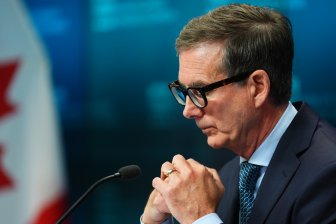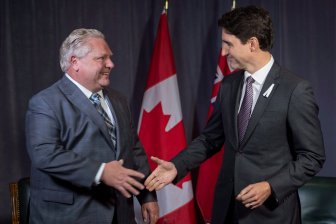Al Monaco may be the outgoing CEO of Canada’s largest energy company, but don’t ask him to predict the price of oil a decade from now – or even next year.
“Anyone who says they can predict energy markets is blowing smoke,” said the 63-year-old CEO of Enbridge Inc. said in an interview last week.
“This industry is not for the faint of heart.”
But Monaco, who will retire on January 1 after 10 years at the helm of the company, is not coy about when he thinks we will reach “peak oil” production in this country. He makes it very clear that he does not believe that day will come soon.
“It is not in this decade. And it is doubtful that it will be in the next decade,” Monaco said.
“It’s hard to see us (the Canadian oil and gas sector) not continuing to grow for another decade or two.”
Read more:
Enbridge Raises Quarterly Dividend, Releases Financial Guidance for 2023
Read more
-
![]()
Enbridge Raises Quarterly Dividend, Releases Financial Guidance for 2023
Many in Canada disagree with that perspective. Some environmental groups say Canadian oil production will peak around 2025 due to the increased global focus on climate change and the rapidly accelerating energy transition.
Even the most recent forecast from the Canada Energy Regulator predicts peak oil production in 2032, seven years earlier than its previous forecast. Some observers have even criticized that outlook as too conservative because it does not take into account government policies such as the upcoming cap on greenhouse gas emissions from the oil and gas industry.
But Monaco’s tenure as Enbridge’s CEO has coincided with a turbulent period for the energy sector, from the boom-time highs of 2012-14 to the devastating oil price crash of 2014-15 to now the war in Ukraine and its upward pressure on energy prices.

He said he believes the turmoil has brought the industry — and most of society — to a kind of middle ground, where climate progress and energy security can co-exist. And that means oil, he said.
“It’s not about ‘either/or,'” Monaco said. “You have to have energy to meet the economic and social needs, but you also have to reduce emissions.”
During his decade in the CEO chair, Monaco led Enbridge through a period of unprecedented growth. The company now has a market capitalization of about $111 billion, and its pipeline network moves about 30 percent of all North America’s crude oil as well as 20 percent of the natural gas consumed in the US.
There was also unrest. The early years of Monaco’s tenure were marked by contentious politics and protests related to large-scale Canadian pipeline projects. Enbridge’s own Northern Gateway pipeline proposal was officially rejected by Prime Minister Justin Trudeau’s government in November 2016.
Monaco calls Northern Gateway “the best project we couldn’t do.” But he says Canada’s energy sector has emerged from those struggles, and those related to other canceled projects like TC Energy’s Energy East and Keystone XL, stronger and wiser.
Read more:
Enbridge reports higher profit, revenue in third quarter
“Things became very polarized in that time frame, and I think it was a real wake-up call for the industry in general,” he said.
“I think it started an upward shift in our industry. We got better because of the pressure.”
That “pressure” has forced the oil and gas sector to become more aware of issues such as climate change and indigenous reconciliation, Monaco said. He said the industry was now “really keen” to reduce emissions. In Enbridge’s case, of the $100 billion the company invested in energy infrastructure projects under Monaco’s tenure, $10 billion was in the form of renewable energy.
This includes major investments in solar and wind, but Enbridge has also accelerated its investment in other lower-carbon technologies such as renewable natural gas, hydrogen and carbon capture and storage.
And it expanded its liquefied natural gas pipeline connections and export capacity, making its first investment in liquefaction by acquiring a 30 percent stake in the Woodfibre LNG project. This facility will be built near Squamish, BC and is expected to be completed in 2027.
Not surprisingly, given the size of the company’s natural gas assets in North America, Monaco remains bullish on both natural gas and Canada’s potential to lead as a global LNG exporter. Enbridge already supplies natural gas to four operating LNG facilities in the Gulf Coast and is poised to supply at least three more.
Environmentalists are critical of Canada’s LNG ambitions. They say having even one large-scale LNG export facility in this country (the LNG Canada project near Kitimat, expected to be operational in 2025) will make it difficult for Canada to meet its climate goals.
Read more:
Calgary-based Enbridge announces the completion of France’s first offshore wind farm
But Monaco is a proponent of the “bridge fuel” argument that natural gas — and by extension, Canadian LNG — can help get other countries off coal.
He also sees it as an important part of the energy security equation within the context of the Ukraine war, natural gas shortages in Europe and rising energy costs for consumers everywhere.
Ultimately, Monaco said Enbridge sees itself as the “quintessential poster child” for an “orderly” energy transition. One of his proudest achievements as CEO was shifting the company’s asset mix to a greater proportion of renewable and lower-carbon energy sources – but he also believes that change takes time.
That’s why Monaco — who will remain with Enbridge in an advisory capacity until March 1 to help the company transition to the leadership of his replacement Greg Abel — is confident oil isn’t going anywhere anytime soon.
“It’s not just conventional, it’s not just nuclear, it’s not just wind and solar,” he said.
“We have to realize and embrace the fact that all those sources of energy are going to be needed, and at the same time we are going to reduce our emissions with the ultimate goal of achieving net-zero emissions by 2050. – with the understanding it will take time to get there.”
© 2022 The Canadian Press






